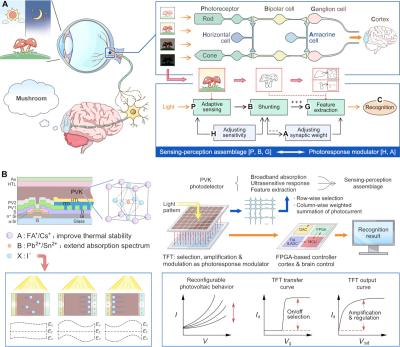Researchers from Shanghai Jiao Tong University, Hefei University of Technology, Korea Advanced Institute of Science and Technology and Tianjin Jinhang Computing Technology Research Institute have developed a retinomorphic hardware prototype that uses a 4096-pixel perovskite image sensor array as core module to endow embodied intelligent vision functionalities.
(A) Adaptive sensing-perception by the biological visual system through the hierarchy of photoreceptors, horizontal cells, bipolar cells, amacrine cells, and ganglion cells. (B) Schematic illustration and working principle of the retinomorphic computing system based on a 4096-pixel 1T-1PD perovskite RSA, microcontroller unit (MCU), and field-programmable gate array (FPGA). ADC, analog-to-digital converter; TIS, trans-impedance amplifier; DAC, digital-to-analog converter. Image from: Science Advances
The team explained that retinomorphic systems that can see, recognize, and respond to real-time environmental information could extend the complexity and range of tasks that an exoskeleton robot can perform to better assist physically disabled people. However, the lack of ultrasensitive, reconfigurable, and large-scale integratable retinomorphic devices and advanced edge-processing algorithms makes it difficult to realize retinomorphic hardware.







